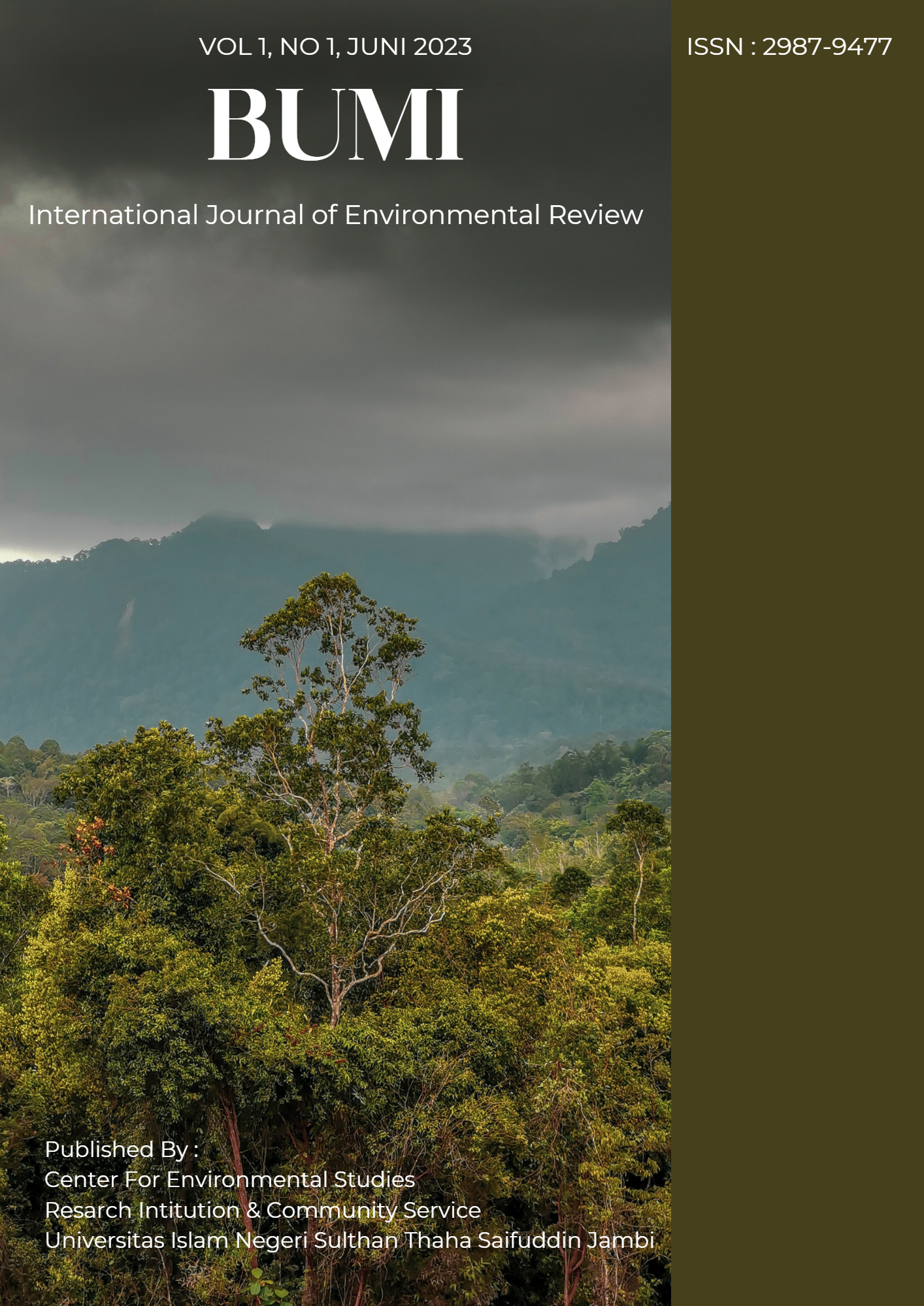The flood points distribution in Dibal Village from 2019 to 2023
DOI:
https://doi.org/10.30631/bumi.v1i01.1902Keywords:
Flood, Rain, EnvironmentAbstract
Floods are natural disasters that commonly occur in tropical countries like Indonesia. Floods often happen in low-lying areas densely populated by residents. The amount and intensity of rainfall have a significant impact on the occurrence of floods at specific points. Population growth and urban development have led to rapid construction, reducing areas for rainwater absorption. This study was conducted in Dibal Village, Ngemplak District, Boyolali Regency, which directly borders Surakarta City. The area has three important facilities as supporting facilities for the region. This research aims to determine the distribution and causes of floods in Dibal Village over the past five years.This research utilized spatial data, analyzed qualitatively using a descriptive approach. Research data were obtained from in-depth interviews and presented in a flood distribution map of Dibal Village. The results of this study identified flood points in Beran Hamlet, North Dibal Hamlet, Central Dibal Hamlet, South Dibal Hamlet, and North Wangkis Hamlet. Among these hamlets, the most severely affected by floods is Beran Hamlet, with flood depths ranging from 30-50 cm and a receding time of 5-9 hours. Meanwhile, North Dibal Hamlet experienced flood depths of 10-30 cm with a receding time of 3-7 hours, Central Dibal Hamlet had flood depths of 10-20 cm with a receding time of 3-5 hours, South Dibal Hamlet had flood depths of 15-25 cm with a receding time of 3-5 hours, and North Wangkis Hamlet had flood depths of 10-25 cm with a receding time of 3-9 hours
References
Afrianto, Y., Marfai, M. A., & Hadi, M. P. (2016). Pemodelan Bahaya Banjir dan Analisis Risiko Banjir Studi Kasus : Kerusakan Tanggul Kanal Banjir Barat Jakarta Tahun 2013. Majalah Geografi Indonesia, 29, 95–110.
Arrighi, C., Ballio, F., & Simonelli, T. (2023). A GIS-based flood damage index for cultural heritage. International Journal of Disaster Risk Reduction, 103654. https://doi.org/10.1016/j.ijdrr.2023.103654
BPS Boyolali. (2019). Kecamatan Ngemplak Dalam Angka 2019.
Iemaaniah, Z. M., Andriyani, R., Dewi, S., Qomariyatuzzamzami, L. N., & Zamani, M. Z. (2023). Conversion Of Productive Agricultural Land With Analysis Of Geographical Information Systems In Dibal Village, 2010-2020 (Vol. 9, Issue 1). https://jurnal.uns.ac.id/GeoEco/article/view/71508/pdf
Mardikaningsih, S. M., Muryani, C., & Nugraha, S. (2017). Studi Kerentanan Dan Arahan Mitigasi Bencana Banjir Di Kecamatan Puring Kabupaten Kebumentahun 2016. Jurnal GeoEco, 3, 157–163.
Menteri Pekerjaan Umum Dan Perumahan Rakyat Republik Indonesia. (2015). Peraturan Menteri Pekerjaan Umum dan Perumahan Rakyat Republik Indonesia.
Nora, A. (2023). BMKG: Curah Hujan Ekstrem Indonesia Meningkat dalam 40 Tahun Terakhir. News.Republika.Co.Id.
Qodriyatun, S. N. (2020). Bencana Banjir: Pengawasan dan Pengendalian Pemanfaatan Ruang Berdasarkan UU Penataan Ruang dan RUU Cipta Kerja. Aspirasi: Jurnal Masalah-Masalah Sosial , 11, 29–42. https://doi.org/10.22212/aspirasi.v11i1.1590
Rosyidie, A. (2013). Banjir: Fakta dan Dampaknya, Serta Pengaruh dari Perubahan Guna Lahan Arief Rosyidie. In Fakta dan Dampaknya, Serta Penngaruh dari Perubahan Guna Lahan Jurnal Perencanaan Wilayah dan Kota (Vol. 24, Issue 3).
Setiawan, H., Jalil, M., Enggi, M., Purwadi, F., Adios, C., Brata, A. W., Syaful Jufda, A., Studi, P., Geografi, P., Keguruan, F., Pendidikan, I., & Mulawarman, U. (2020). Analisis Penyebab Banjir Di Kota Samarinda. In Jurnal Geografi Gea (Vol. 20, Issue 1). https://ejournal.upi.edu/index.php/gea
Sugandi, D. (2016). Model Penanggulangan Banjir. Jurnal Geografi UPI.
Utomo, D. H. (2016). Morfologi Profil Tanah Vertisol Di Kecamatan Kra-Ton, Kabupaten Pasuruan. http://journal.um.ac.id/index.php/
Weday, M. A., Tabor, K. W., & Gemeda, D. O. (2023). Flood hazards and risk mapping using geospatial technologies in Jimma City, southwestern Ethiopia. Heliyon, e14617. https://doi.org/10.1016/j.heliyon.2023.e14617
Downloads
Published
Issue
Section
License
Copyright (c) 2023 Zuhdiyah Matienatul Iemaaniah, Latifah Nurul Qomariyatuzzamzami, Muhammad Zaki Zamani

This work is licensed under a Creative Commons Attribution-NonCommercial-ShareAlike 4.0 International License.
BUMI: International Journal of Environmental Reviews provides immediate open access to its content on the principle that making research freely available to the public to supports a greater global exchange of knowledge.



